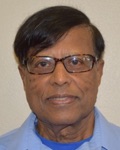Workshop 4
A New Look at Transformation Optics (TO) Approach for Designing Electromagnetic Devices such as Flat Lenses, and Cloaks

- Name
- Prof. Raj Mittra
- Affiliation
- Pennsylvania State University / University of Central Florida, USA
Abstract
In this tutorial presentation we will discuss the basics of the Transformation Optics (TO) method, aka the Transformation Electromagnetics approach, to designing a number of “microwave” devices such as: cloaks; flat lenses; and reflectarrays. Recently, there has been considerable interest in using the transformation optics (TO) algorithm, which is based upon transforming the geometry of an object from real space to virtual space while keeping the Maxwell’s field solutions from real space to virtual space intact, because it provides an alternative (to traditional) and innovative way to design a class of EM devices. However, the caveat is that the TO algorithm typically leads to designs that call for anisotropic epsilon and mu values in real space, in order to preserve the field variations as we navigate from the real space to virtual space and vice versa. Furthermore, depending on the geometry of the problem, the values may be very unrealistic to realize in practice, even when artificially synthesized materials aka metamaterials (MTM) are employed for the realization, whose use often leads to designs that are narrowband, lossy, dispersive and polarization-sensitive—attributes that are clearly undesirable for practical applications. We show how we can address this problem encountered with the TO by using an algorithm based on “Field Transformation (FT),” as opposed to geometry transformation. The FT algorithm has been designed to transform the electromagnetic field distribution in an input aperture, generated by a given source distribution, to a desired distribution in the exit aperture. We show how we can cast the design problem into a Scattering Matrix approach, where in the case of RCS reduction problem the design is based on controlling only the Magnitude of S11, whereas for the Lens or Reflectarray problems, we are specifying only the desired Phase of S12 without being concerned about its magnitude. In contrast to this, the TO imposes strict conditions on both the magnitude and phase characteristics of S11 and S12, which in turn calls for anisotropic dielectric and magnetic metamaterials. The Scattering Matrix/Field Transformation approach avoids these problems altogether and is able to work with epsilon-only materials for the lens and reflectarray problems, and with realizable magneto-dielectrics with complex Mu and epsilon materials, which have wideband characteristics and which do not suffer from the shortcomings of the MTMs.
A number of practical examples will be included in the presentation, not only to point out the shortcomings of the TO, but to also show how we can get around its difficulties in a systematic way when dealing with some real-world problems.
About the speaker
Raj Mittra is Professor in the Electrical Engineering department of the Pennsylvania State University. He is also the Director of the Electromagnetic Communication Laboratory, which is affiliated with the Communication and Space Sciences Laboratory of the EE Department. Prior to joining Penn State he was a Professor in Electrical and Computer Engineering at the University of Illinois in Urbana Champaign. He is a Life Fellow of the IEEE, a Past-President of AP-S, and he has served as the Editor of the Transactions of the Antennas and Propagation Society. He won the Guggenheim Fellowship Award in 1965, the IEEE Centennial Medal in 1984, the IEEE Millennium medal in 2000, the IEEE/AP-S Distinguished Achievement Award in 2002, the AP-S Chen-To Tai Distinguished Educator Award in 2004 and the IEEE Electromagnetics Award in 2006. He has been a Visiting Professor at Oxford University, Oxford, England and at the Technical University of Denmark, Lyngby, Denmark. He has also served as the North American editor of the journal AEÜ. His professional interests include the areas of Communication Antenna Design, RF circuits, computational electromagnetics, electromagnetic modelling and simulation of electronic packages, EMC analysis, radar scattering, frequency selective surfaces, microwave and millimetre wave integrated circuits, and satellite antennas. He has published over 1000 journal and symposium papers and more than 40 books or book chapters on various topics related to electromagnetics, antennas, microwaves and electronic packaging. He also has four patents on communication antennas to his credit. He has supervised about 100 Ph.D. theses, 85 M.S. theses, and has mentored more than 50 postdocs and Visiting scholars. He has directed, as well as lectured in, numerous short courses on Computational Electromagnetics, Electronic Packaging, Wireless antennas, Metamaterials and Transformation Optics, both nationally and internationally.





















